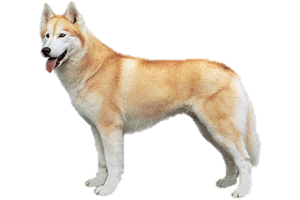Siberian Husky
Arctic Husky, Chukchi Sled Dog, Siberian Chukchi

The Siberian Husky is the smallest and fastest of the sled dogs, built for carrying light loads at high speeds. It is believed that the name ‘husky’ is derived either from Europeans mispronouncing ‘chukchi’ or as a slang abbreviation of ‘eskimo.’ During WWII the Siberian Husky was heavily used in the Arctic Circle by the United States military for search and rescue.
Siberian Husky Standards
- AKC (Working)
- FCI (Group 5)
- KC (Working)
- UKC (Northern)
- 20-24"
- 35-60 lbs
- medium-sized spitz
- erect, triangular ears
- long tail, carried in a sickle when alert
- double- coated, outer coat is straight and harsh
- can be any color
History of the Siberian Husky
It is believed the Siberian Husky is one of the oldest and undiluted of all the breeds. Some have claimed that it has been bred for as long as 3,000 years in the remote isolated region of northeast Siberia by the native nomads, the Chukchi. The women of the tribe cared for the dogs when they were not working, which mean that the dogs had to be non-aggressive, particularly around children. Custom dictated that all but the best dogs were castrated, which further improved the breed. The economic and religious life was centered around the Chukchi's dogs, as well as survival. These dogs would transport a man to ice fish and then return him home – sometimes traveling as much as 100 miles in a single day. The richest members of the community owned the best dogs and the dogs were the reason for their prosperity.
Once these dogs were being imported to the Alaska they were an immediate sensation in the racing world, easily beating the larger native Alaskan Malamutes and Canadian Eskimo Dogs. They achieved even higher fame in the winter of 1925 when a serious diphtheria epidemic hit Nome, Alaska and serum had to be transported via a relay of sled teams. The team run by Leonhard Seppala and his Siberian Huskies traveled over 340 miles, no other team covered more then 53.
